Japanese, Asian, Zen. Gardens designed with an Eastern sensibility go by many names, but they all share recognizable traits. Those traits are typically aesthetic (artistically placed rocks), symbolic (statues of the Buddha) or sensory (the sound of falling water), though there is nothing against breaking from tradition and incorporating a functional component — namely, edible plants.
An Asian edible garden looks the part, except food plants are integrated where possible. Sometimes it’s a matter of substituting an edible version of a traditional Asian ornamental. Other times it’s as simple as recognizing some of the food plants that are already part of the Asian plant palette and making a harvest. Above all it’s about getting to know some of the traditional species involved in Asian cuisine.

Adamson + Molina
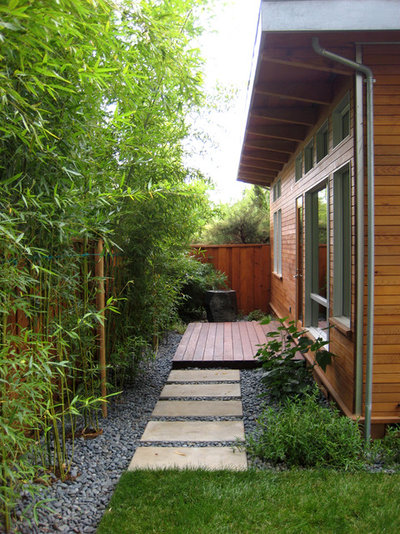
Rich Mathers Construction, Inc.
Start with ornamentals that are also edible. Bamboo is a classic example of an in-the-closet edible. Ever had bamboo shoots? They are the emerging shoots of bamboo canes cut just as they poke through the soil. All bamboo species are technically edible, but species like sweetshoot bamboo (
Phyllostachys dulcis,
USDA zones 7 to 10; find your zone) and tortoise shell bamboo (
P. edulis,
zones 7 to 10) are among the most delicious.
Bamboo is a versatile plant that fits any number of niches in an Asian garden, with varieties ranging from under 6 feet to over 60 feet tall and thriving in both sun and shade. While bamboo has a reputation for being invasive, it’s important to realize that trait applies only to running bamboo — clumping varieties stay put where you plant them. Even running varieties can be contained with an underground barrier or by planting them in an aboveground planter.
Learn more about growing bamboo in a small garden

Daniel Moran Architect
Lotus flowers are icons of enchantment among Western gardeners, but in Asia, they’re actually a staple food source. It’s mainly the fleshy root that’s eaten. Lotuses aren’t easy to grow without a very long, hot growing season, but if you’re successful, try digging out one of the roots and incorporating it in a stir-fry along with your bamboo shoots.
Plant lotuses in a rich soil mixture using a basin that is wider than tall. Once temperatures have warmed in spring, submerge the basin about 12 inches deep in a water feature to create the ultimate Zen garden ambience.
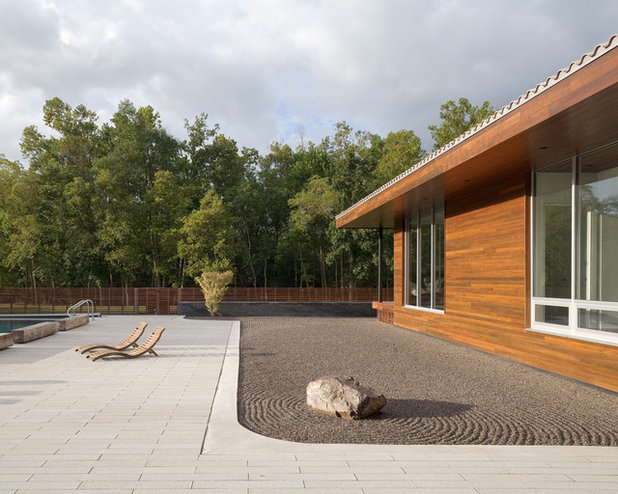 Emphasize a focal point with an edible.
Emphasize a focal point with an edible. In the name of spaciousness and tranquility, Asian gardens are often sparse on plant materials, so when you’re contemplating a botanical focal point, think carefully about the edible options. In truth any fruit tree, shrub or vine can fit an Asian motif if complemented by traditional features, such as a sand garden, pagoda lantern, bamboo fence or gong.
But there are some Asian food plants that will really set the tone: Japanese eggplants, with their thin, graceful curves; kiwis (
Actinidia deliciosa) with their fuzzy, bright red stems; or perhaps a loquat tree (
Eriobotrya japonica), an unusual evergreen fruit tree with a decidedly Oriental flair.
 Use spring-flowering fruit trees
Use spring-flowering fruit trees. Flowering plums are one of the most elegant fruit trees in the Asian cornucopia. They are an ancient symbol of Japan, where the spring bloom is celebrated every year with festivals. Rather than plant an ornamental plum, plant a good edible variety — they are just as spectacular when in flower. If you want to get really authentic, look for an ume plum (
Prunus mume), which is used to make the traditional dish of umeboshi (pickled plums).
Photo by fumihirokato
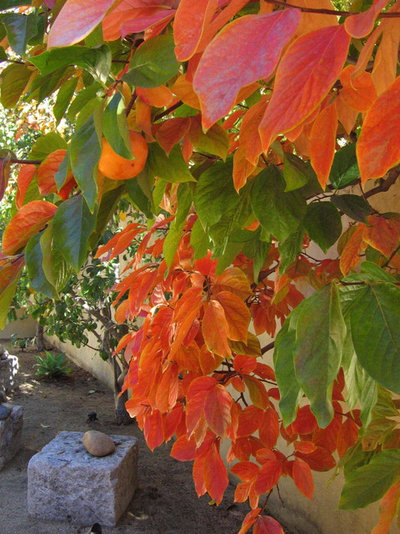
Kathleen Shaeffer Design, Exterior Spaces
The Asian persimmon is another traditional Eastern fruit that is increasing in popularity in American gardens. As with the loquat and flowering plum, something about its appearance just feels right in an Asian-inspired garden. The fruit ripens just as the leaves turn brilliant sunset colors in autumn, and then hangs on the bare branches until the new year.
Fruit trees are the perfect focal point for sunny locations in Asian landscapes. Keep the surrounding vegetation sparse to really highlight the form of the tree, limiting the understory plantings to moss, a tidy evergreen ground cover or perhaps just sand and rocks.
See how to grow your own persimmon tree
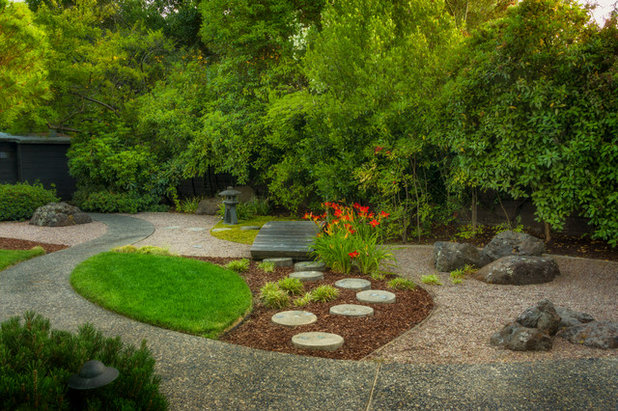
Kikuchi + Kankel Design Group
Design with flavor in mind. Asian food traditions are all about strongly flavored garnishes, just as Asian gardens are all about striking contrasts against a still and reverent canvas. When you’re going to break from the use of calm, austere plantings and add something bright to the landscape, think edible. Daylilies (
Hemerocallis spp, pictured here) are another common ornamental that few gardeners realize is edible — the blossoms are commonly used in spicy Asian stir-fries.
Daylilies are suitable for any sunny or partially shaded niche in an Asian landscape — just keep it simple and resist the urge to clutter the planting with multiple daylily varieties or other flowering species.

Andrea Meyers
Speaking of spicy, hot peppers are another candidate to bring color and flavor into an Asian landscape. Red is the most prominent color used in Asian design, and cayenne peppers are a great way to add it in a small, yet potent, way.
Ornamental hot peppers, like this one with its dark foliage, work best in an Asian landscape when integrated in a glazed pot. Try planting one per pot alongside eggplant and decorative Asian herbs like Thai basil and shiso, a mint-family herb often eaten with sushi.
See how to grow peppers
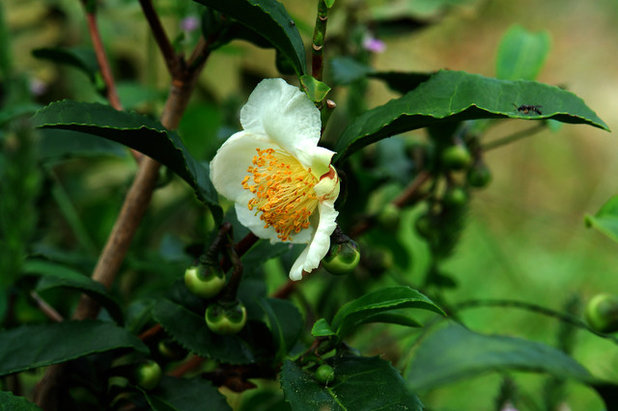
What better beverage to follow an Asian meal than a cup of green tea? Few gardeners realize the source of this herb: It’s actually made from the leaves of camellias, particularly
Camellia sinensis, a shade-loving shrub that thrives in acidic soil.
Camellias are the quintessential flowering shrub for Asian shade gardens — now that you know their more practical purpose, you can enjoy the blossoms outdoors and snip the leaves to bring inside for a healthy drink.
More:Browse more guides to gardening with edibles
See more inspiring garden styles





